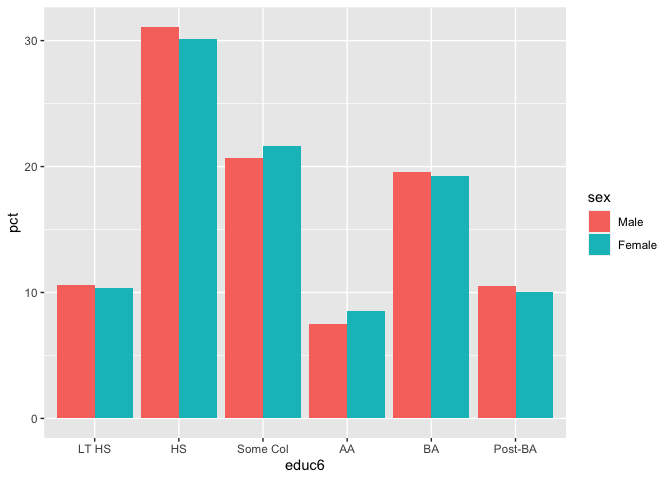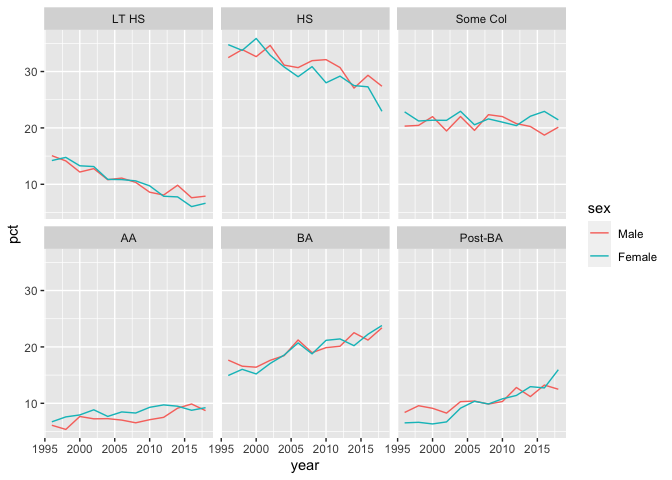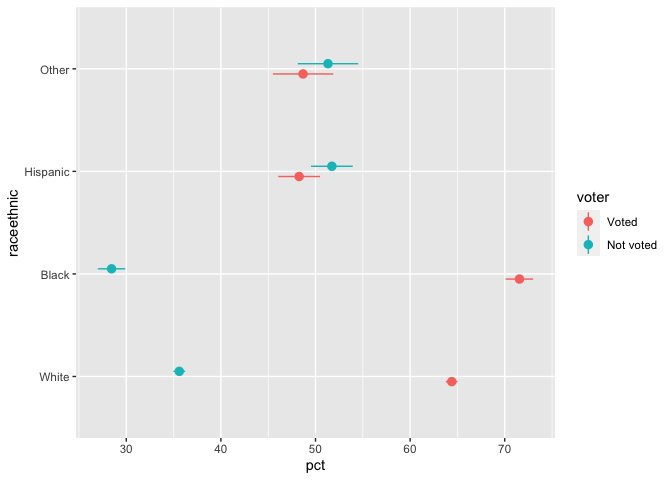Calculate Crosstab and Topline Tables of Weighted Survey Data.
Weighted data survey tables in R
John Johnson 3/9/2020
pollster is an R package for making topline and crosstab tables of simple weighted survey data. The package is designed for use with labelled data, like what you might use the haven package to import from Stata or SPSS. It follows tidyverse programming conventions, and output tables are also in the form of a tidy data frame, or tibble.
Only simple weights are currently supported. For complex survey designs, we recommend the excellent survey package.
The core functions are:
topline()crosstab()crosstab_3way()
Each of these functions also has a twin version which includes a column for the margin of error calculated to include the design effect of the weights.
moe_topline()moe_crosstab()moe_crosstab_3way()
There are also two special functions which calculate the design effect component of the margin of error for each survey wave independently.
moe_wave_crosstab()moe_wave_crosstab_3way()
Other functions are included to calculate simple weighted summary statistics.
wtd_mean()is a tidy-compliant wrapper aroundstats::weighted.mean()summary_table()returns a tible with summary statistics similar to the Stata commandsum
Installation
Install it this way.
install.packages("pollster")
Or get the development version.
remotes::install_github("jdjohn215/pollster")
Basic usage
pollster includes a dataset of Illinois responses to the Current Population Survey’s voter registration supplement.
library(pollster)
head(illinois)
#> # A tibble: 6 x 10
#> year fips sex educ6 raceethnic maritalstatus rv voter age
#> <dbl> <dbl+l> <dbl+l> <dbl+l> <dbl+lbl> <dbl+lbl> <dbl+l> <dbl+l> <dbl>
#> 1 1996 17 [IL] 1 [Mal… 2 [HS] 1 [White] 1 [Married] 2 [Not… 2 [Not… 29
#> 2 1996 17 [IL] 2 [Fem… 3 [Som… 1 [White] 1 [Married] 1 [Reg… 1 [Vot… 28
#> 3 1996 17 [IL] 2 [Fem… 2 [HS] 1 [White] 3 [Never Mar… 1 [Reg… 1 [Vot… 82
#> 4 1996 17 [IL] 2 [Fem… 2 [HS] 1 [White] 3 [Never Mar… 1 [Reg… 1 [Vot… 72
#> 5 1996 17 [IL] 1 [Mal… 2 [HS] 2 [Black] 1 [Married] 1 [Reg… 1 [Vot… 75
#> 6 1996 17 [IL] 2 [Fem… 2 [HS] 2 [Black] 1 [Married] 1 [Reg… 1 [Vot… 60
#> # … with 1 more variable: weight <dbl>
Make a topline table like this. The output is a tibble.
topline(df = illinois, variable = maritalstatus, weight = weight)
#> # A tibble: 3 x 5
#> Response Frequency Percent `Valid Percent` `Cumulative Percent`
#> <fct> <dbl> <dbl> <dbl> <dbl>
#> 1 Married 55001786. 53.6 53.6 53.6
#> 2 Widow/divorced/Sep 18635087. 18.1 18.1 71.7
#> 3 Never Married 29041640. 28.3 28.3 100
Make a crosstab like this.
crosstab(df = illinois, x = educ6, y = maritalstatus, weight = weight)
#> # A tibble: 6 x 5
#> educ6 Married `Widow/divorced/Sep` `Never Married` n
#> <fct> <dbl> <dbl> <dbl> <dbl>
#> 1 LT HS 40.0 29.1 30.9 10770999.
#> 2 HS 52.9 21.0 26.1 31409418.
#> 3 Some Col 44.6 17.4 38.0 21745113.
#> 4 AA 57.4 18.4 24.2 8249909.
#> 5 BA 61.1 11.3 27.6 19937965.
#> 6 Post-BA 70.7 12.9 16.5 10565110.
If you prefer, you can also get the output in long format.
crosstab(df = illinois, x = educ6, y = maritalstatus, weight = weight, format = "long")
#> # A tibble: 18 x 4
#> educ6 maritalstatus pct n
#> <fct> <fct> <dbl> <dbl>
#> 1 LT HS Married 40.0 10770999.
#> 2 LT HS Widow/divorced/Sep 29.1 10770999.
#> 3 LT HS Never Married 30.9 10770999.
#> 4 HS Married 52.9 31409418.
#> 5 HS Widow/divorced/Sep 21.0 31409418.
#> 6 HS Never Married 26.1 31409418.
#> 7 Some Col Married 44.6 21745113.
#> 8 Some Col Widow/divorced/Sep 17.4 21745113.
#> 9 Some Col Never Married 38.0 21745113.
#> 10 AA Married 57.4 8249909.
#> 11 AA Widow/divorced/Sep 18.4 8249909.
#> 12 AA Never Married 24.2 8249909.
#> 13 BA Married 61.1 19937965.
#> 14 BA Widow/divorced/Sep 11.3 19937965.
#> 15 BA Never Married 27.6 19937965.
#> 16 Post-BA Married 70.7 10565110.
#> 17 Post-BA Widow/divorced/Sep 12.9 10565110.
#> 18 Post-BA Never Married 16.5 10565110.
A three-way crosstab is just a normal crosstab with a third control variable. Often, this third variable is time.
crosstab_3way(df = illinois, x = educ6, y = maritalstatus, z = year, weight = weight)
#> # A tibble: 72 x 6
#> educ6 year n Married `Widow/divorced/Sep` `Never Married`
#> <fct> <dbl> <dbl> <dbl> <dbl> <dbl>
#> 1 LT HS 1996 1182402. 41.0 28.8 30.2
#> 2 LT HS 1998 1159148. 42.2 33.6 24.2
#> 3 LT HS 2000 1036154. 44.3 32.6 23.1
#> 4 LT HS 2002 1074704. 38.0 30.4 31.6
#> 5 LT HS 2004 936926. 41.0 30.3 28.6
#> 6 LT HS 2006 918858. 38.6 31.7 29.7
#> 7 LT HS 2008 909755. 42.1 28.1 29.8
#> 8 LT HS 2010 806647. 40.6 24.6 34.7
#> 9 LT HS 2012 705132. 35.7 26.9 37.4
#> 10 LT HS 2014 782926. 43.7 23.7 32.7
#> # … with 62 more rows
Making tables and graphs
Wide format is best for displaying table output. Long format is best for making graphs. pollster outputs dovetail seamlessly with knitr::kable() and ggplot2::ggplot(). These examples show very basic html table output, but you can customize the appearance of your tables almost endlessly in either html or pdf formats using Hao Zhu’s excellent kableExtra package.
library(dplyr)
#>
#> Attaching package: 'dplyr'
#> The following objects are masked from 'package:stats':
#>
#> filter, lag
#> The following objects are masked from 'package:base':
#>
#> intersect, setdiff, setequal, union
crosstab(df = illinois, x = sex, y = educ6, weight = weight) %>%
knitr::kable(digits = 0)
| sex | LT HS | HS | Some Col | AA | BA | Post-BA | n |
|---|---|---|---|---|---|---|---|
| Male | 11 | 31 | 21 | 7 | 20 | 11 | 49108796 |
| Female | 10 | 30 | 22 | 9 | 19 | 10 | 53569718 |
library(ggplot2)
crosstab(df = illinois, x = sex, y = educ6, weight = weight, format = "long") %>%
ggplot(aes(educ6, pct, fill = sex)) +
geom_bar(stat = "identity", position = "dodge")

Three-way crosstabs are ideal for plotting time series graphs and/or faceted plots.
crosstab_3way(df = illinois, x = sex, y = educ6, z = year, weight = weight, format = "long") %>%
ggplot(aes(year, pct, col = sex)) +
geom_line() +
facet_wrap(facets = vars(educ6))

Margin of error
Each pollster function comes with a twin function which includes a margin of error column. For example:
moe_topline(df = illinois, variable = voter, weight = weight)
#> # A tibble: 2 x 6
#> Response Frequency Percent `Valid Percent` MOE `Cumulative Percent`
#> <fct> <dbl> <dbl> <dbl> <dbl> <dbl>
#> 1 Voted 56230937. 63.7 63.7 0.551 63.7
#> 2 Not voted 32070164. 36.3 36.3 0.551 100
By default, moe_crosstab output comes in long format, but you can also specify wide format.
moe_crosstab(df = illinois, x = raceethnic, y = voter, weight = weight, format = "wide")
#> # A tibble: 4 x 6
#> raceethnic n pct_Voted `pct_Not voted` moe_Voted `moe_Not voted`
#> <fct> <int> <dbl> <dbl> <dbl> <dbl>
#> 1 White 24167 64.4 35.6 0.624 0.624
#> 2 Black 3980 71.6 28.4 1.45 1.45
#> 3 Hispanic 2106 48.3 51.7 2.21 2.21
#> 4 Other 1006 48.7 51.3 3.19 3.19
moe_crosstab(df = illinois, x = raceethnic, y = voter, weight = weight) %>%
ggplot(aes(x = pct, y = raceethnic, xmin = (pct - moe), xmax = (pct + moe), color = voter)) +
geom_pointrange(position = position_dodge(width = 0.2))

Summary table
summary_table() creates a simple summary table of a weighted numeric variable.
summary_table(df = illinois, variable = age, weight = weight)
#> # A tibble: 1 x 8
#> variable_name unweighted_obse… weighted_observ… weighted_mean min_value
#> <chr> <int> <dbl> <dbl> <dbl>
#> 1 age 36207 102678514. 46.2 18
#> # … with 3 more variables: max_value <dbl>, missing_observations <int>,
#> # missing_weighted_observations <dbl>
You can choose name_style = "pretty" if you want column headings appropriate for a formatted table.
summary_table(df = illinois, variable = age,
weight = weight, name_style = "pretty") %>%
knitr::kable()
| Variable | Unweighted obs | Weighted obs | Weighted mean | Min | Max | Unweighted missing | Weighted missing |
|---|---|---|---|---|---|---|---|
| age | 36207 | 102678514 | 46.19646 | 18 | 90 | 0 | 0 |